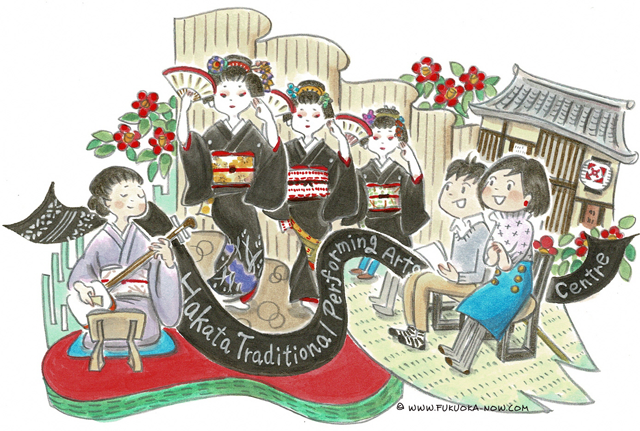Hakata Culture vol.143
Meet Geigi at the Hakata Traditional Performing Arts Centre

Across from Kushida Shrine sits a building with traditional lattice doors. This is the Hakata Traditional Performing Arts Centre, which opened in 2017 to spread the word about Hakata’s traditional arts, like Japanese-style dance, folk singing, and Hakata niwaka—a kind of traditional improvisational comedy. The Centre, however, is not typically open to the public because it is where geigi—another term for geisha—are trained by Hakata Kenban, the official association for these traditional entertainers.
Of course, you can enter the Centre when it holds its regular performances, which include singing and dancing by the geigi, ozashiki-asobi (parlor games) and a commemorative photo with the geigi. The Centre affords an invaluable experience because you can usually only interact with geigi at teahouses. Depending on the day, you may also be able to enjoy other local traditional performing arts. Be sure to check the homepage for performance dates and times.
Geigi are said to have started performing in Hakata in the middle of the Edo era. Back then, geigi from Osaka were invited to perform at teahouses in Nagasaki, but due to a law that limited stays there to 100 days at a time, the geigi would come to Hakata to entertain guests for a certain period of time before returning to Nagasaki. After a while, some geigi moved to Hakata permanently, making them the forebears of today's Hakata geigi.
Records indicate that geigi numbered more than 2,000 in the Meiji and Taisho eras (1868-1926). The first geigi training association, or kenban, was established in 1889, and at the peak of geigi popularity, the city boasted five kenban. The numbers of geigi and kenban both dwindled over time, and now there is only one kenban and around 20 geigi in the city. You can see the elegantly-styled entertainers perform every January at the kachi-mairi parade at Toka Ebisu Shrine, every May at the Hakata Dontaku, and every December at the Hakata Odori.
お座敷遊びも体験できる博多伝統芸能館
博多の守り神「櫛田神社」の向かいにある格子戸の落ち着いた建物。ここは2017年にオープンした博多の伝統芸能を体験できる新しい文化施設「博多伝統芸能館」です。日本舞踊や民謡、独楽、博多にわかなど、博多に伝わる伝統芸能の魅力を発信することを目的につくられました。とはいえ普段は入ることはできません。博多券番の芸妓の稽古場となっているからです。
ただし、定期的に行われる伝統芸能の公演で中に入ることができます。公演内容は博多芸妓による唄と舞い、簡単なお座敷遊びの体験、芸妓との記念撮影などです。通常は料亭などの席でしか体験できない芸妓のもてなしを楽しめる貴重な機会です。また日によっては芸妓以外の博多の伝統芸能が参加することもあります。公演日時や内容は同館のホームページをチェックしてみてください。
博多の芸妓は江戸時代の中頃に登場したといわれています。当時は大阪の芸妓が長崎の茶屋などに招かれていましたが、長崎で滞在できるのは100日以下と定められていたので、一時的に博多などに滞在して客をもてなし、長崎に戻っていました。そのうちに博多に定住する芸妓が現れて、博多芸妓のルーツになったとされます。明治、大正時代には2000名を超える芸妓がいたそうです。
芸妓の取り次ぎをする券番が、博多に初めてできたのは1889(明治22)年。最盛期には5つの券番がありました。時代の流れとともに芸妓も券番も減っていき、現在では博多券番ひとつに統一され、約20名の芸妓が所属しています。あでやかな姿は1月の十日恵比寿大祭での「かち詣り」、5月の博多どんたく、12月の博多をどりなどでも見ることができます。

